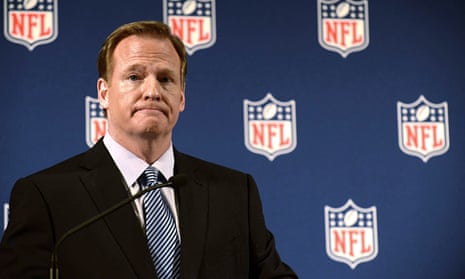Ray Rice coldcocking his fiancée and dragging her unconscious body like a rag doll from an elevator; Adrian Peterson stuffing leaves in his four-year-old son’s mouth before lacerating him with a branch. Even if your awareness of American football begins with “Super” and ends with “Bowl”, the bloodcurdling violence wrought by two of the sport’s biggest stars has been difficult to avoid, let alone fathom. Meanwhile in the week in which the NFL begins a three-game residency at Wembley Time magazine has raised another issue that will not go away: the grim number of traumatic brain injuries in American football.
Time’s front-page headline, alongside a photograph of a 16-year-old defensive back, Chad Stover, who died while playing for his high school, asks a stark question: Is football worth it? It was a horrible tragedy. But given that more than 1.1 million people play high school gridiron each year and 67,000 of them are diagnosed with concussion, such tragedies are not entirely unexpected. We also know that brain autopsies on former NFL players, including Junior Seau who committed suicide in 2012, have shown evidence of chronic traumatic encephalopathy, a progressive degenerative brain disease resulting from repeated head trauma.
Earlier this month the NFL estimated that 28% of its former players will develop Alzheimer’s or dementia, a significantly higher risk than the general population, but the latest analysis from researchers at Purdue University goes further, showing what happens to players’ brains throughout the year by using accelerometer sensors at every practice and game to measure the severity of each impact, as well as brain scans before, during and after the season.
What they found shocked them. Professor Eric Nauman, the director of the Human Injury Research and Regenerative Technologies Laboratory, has said they found damage to the parts of the brain that affect emotional response, higher reasoning and ability to visualise, in children as young as 14 or 15. His colleague professor Tom Talavage says over 50% of the high school American football athletes they have studied “exhibit appreciable changes in brain neurophysiology that can persist for up to two years beyond the time at which the athlete ceases to participate in the sport, perhaps longer”.
And most worrying of all, in the 190 high school footballers in Indiana they have monitored over the past six years they repeatedly found severe changes to the brain that do not show up as concussion symptoms and so would not have been spotted without regular scans, including magnetic resonance imaging (MRI), structural imaging and functional imaging (fMRI), and a chemical analysis looking at the health of the brain from a variety of viewpoints.
Their research has showed that the old way of thinking – that heavy blows lead to concussions – is incomplete. The biggest on-field “hit” they have recorded, for instance, is 289 g, which led to no immediate injury for the recipient beyond a sore neck. In fact, repeated minor hits can damage the brain and make it more susceptible to serious trauma. As Nauman explains: “Now we know there is this gradual build-up and your brain is always trying to heal. It is not that different from your muscles when you exercise; they get sore but when you rest they heal. The difference is your brain often doesn’t send the signal that it is sore.”
This makes grim reading for American football fans. Last year the author Malcolm Gladwell predicted the sport would become “ghettoised”, adding we would get to a point “where we will disclose the risks and essentially dare people to play”. The Purdue University team disagree. They believe helmets can be designed to absorb more energy, brain changes tracked and potentially predicted based on the history of hits to the head, and the dangers reduced by players missing practices rather than games.
“What we have done in technology so far to keep players safe is almost nothing,” Nauman says. “We could have sensors in helmets that call penalties automatically so you stop head-to-head hits – that’s not hard. There is no doubt we could make American football much, much safer. Perhaps not as safe as cross-country running but very close.”
Yet so far the NFL or NCAA have shown very little interest in the research – much to their frustration. They are focusing on finding out the biggest hit the brain can take without damage and designing safety equipment for high school kids.
Incidentally the Purdue researchers are looking at women’s high school soccer – and early results show that there are smaller, but noticeable, effects to around 30% of players’ brains, with headers from goal-kicks causing much of the damage. “Most ‘hits’ in soccer are under 20 g which shouldn’t cause any problem,” Nauman says. “But once you start getting 30 or 40 g they add up over time and, if you practise, say, 100 of these headers a day, you start breaking lots of connections. Even goalkeepers repeatedly diving on hard pitches can cause problems.”
Such research also presents challenges for other contact sports such as rugby union and boxing. “For 30 years all people had were the outward symptoms of concussion,” Nauman says, “but now we finally have the ability to look inside the brain throughout the season – and to be perfectly honest, it is a lot scarier than we expected.”

